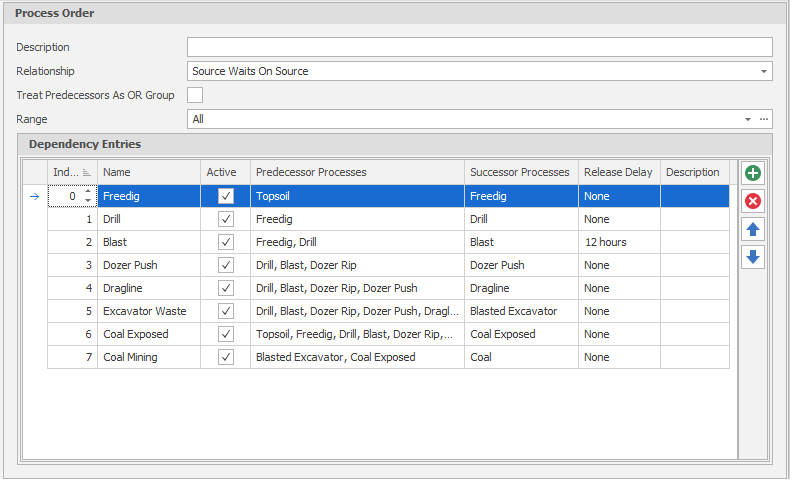Process Order Dependencies 
A Process Order Dependency is used to set dependencies between different processes
When you add or edit a Dependency of this type, you can set the following parameters (or accept the defaults where applicable):
Description
Optionally, enter a Description that can be used with the Name to further identify the Dependency. Detail useful for diagnosing issues with Dependencies should be added here.
Colour
Use the drop-down to differentiate this type of dependency by colour in the Animation Window.
Relationship
The Predecessor to Successor Relationship. Defaults to Source Waits on Source. Source Waits On Destination means a Source Task is waiting on a Destination Task to be finished.
Treat Predecessors as OR Group
Where multiple predecessor tasks have the same successor task and the OR check box is NOT enabled, the successor task will only be released after ALL of the predecessor tasks are completed.
Where multiple predecessor tasks have the same successor task and the OR check box is enabled, then the successor task will be released when ANY of the predecessor tasks are completed.
Priority
The Priority is a numerical method to classify your dependencies by importance. Ranges with Priority 1 will be resolved first, meaning if there are conflicting dependencies between two or more ranges, ranges with lower priority will become circular, rather than randomly resolving the conflict.
Range
Set the Source (Text Range or [Inline] *) Range that applies to the Tasks. See: Text Range and Inline Ranges.
Dependency Entries
Use the local toolbar to add Dependency Entries. Copy, Insert Copy and Move options are available when you right-click on a Dependency Entry. Other options will depend on the dependency type.
|
|
Add a new item to the list. |
|
|
Delete the item(s) currently selected in the list. |
|
|
Move the currently selected item(s) Up to reorder the list. |
|
|
Move the currently selected items) Down to reorder the list. |
Name
The Name used to identify the Dependency Entry in the Snapshot Viewer.
Active
Use the Active check box to toggle the inclusion/exclusion of the Entry in the Schedule.
Predecessor/Successor Processes
Allows you to control which Processes are used for the Dependency.
Release Delay
Once a Predecessor Range has been completed, the Release Delay controls how long until the Successor Range is considered "Released" and can be worked. Accept the default (None) or build a Release Delay Expression using the operators, constants and functions provided by the Expression Editor.
Description
Optionally, enter a Description that can be used with the Name to further identify the Dependency Entry.
Colour
Click the Colour box to set a colour to identify the Entry in the Snapshot Viewer.
